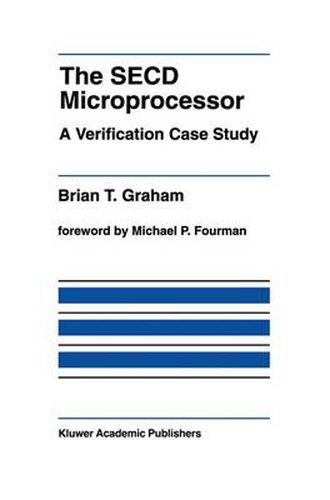Readings Newsletter
Become a Readings Member to make your shopping experience even easier.
Sign in or sign up for free!
You’re not far away from qualifying for FREE standard shipping within Australia
You’ve qualified for FREE standard shipping within Australia
The cart is loading…






This title is printed to order. This book may have been self-published. If so, we cannot guarantee the quality of the content. In the main most books will have gone through the editing process however some may not. We therefore suggest that you be aware of this before ordering this book. If in doubt check either the author or publisher’s details as we are unable to accept any returns unless they are faulty. Please contact us if you have any questions.
This is a milestone in machine-assisted microprocessor verification. Gordon [20] and Hunt [32] led the way with their verifications of sim ple designs, Cohn [12, 13] followed this with the verification of parts of the VIPER microprocessor. This work illustrates how much these, and other, pioneers achieved in developing tractable models, scalable tools, and a robust methodology. A condensed review of previous re search, emphasising the behavioural model underlying this style of verification is followed by a careful, and remarkably readable, ac count of the SECD architecture, its formalisation, and a report on the organisation and execution of the automated correctness proof in HOL. This monograph reports on Graham’s MSc project, demonstrat ing that - in the right hands - the tools and methodology for formal verification can (and therefore should?) now be applied by someone with little previous expertise in formal methods, to verify a non-trivial microprocessor in a limited timescale. This is not to belittle Graham’s achievement; the production of this proof, work ing as Graham did from the previous literature, goes well beyond a typical MSc project. The achievement is that, with this exposition to hand, an engineer tackling the verification of similar microprocessor designs will have a clear view of the milestones that must be passed on the way, and of the methods to be applied to achieve them.
$9.00 standard shipping within Australia
FREE standard shipping within Australia for orders over $100.00
Express & International shipping calculated at checkout
This title is printed to order. This book may have been self-published. If so, we cannot guarantee the quality of the content. In the main most books will have gone through the editing process however some may not. We therefore suggest that you be aware of this before ordering this book. If in doubt check either the author or publisher’s details as we are unable to accept any returns unless they are faulty. Please contact us if you have any questions.
This is a milestone in machine-assisted microprocessor verification. Gordon [20] and Hunt [32] led the way with their verifications of sim ple designs, Cohn [12, 13] followed this with the verification of parts of the VIPER microprocessor. This work illustrates how much these, and other, pioneers achieved in developing tractable models, scalable tools, and a robust methodology. A condensed review of previous re search, emphasising the behavioural model underlying this style of verification is followed by a careful, and remarkably readable, ac count of the SECD architecture, its formalisation, and a report on the organisation and execution of the automated correctness proof in HOL. This monograph reports on Graham’s MSc project, demonstrat ing that - in the right hands - the tools and methodology for formal verification can (and therefore should?) now be applied by someone with little previous expertise in formal methods, to verify a non-trivial microprocessor in a limited timescale. This is not to belittle Graham’s achievement; the production of this proof, work ing as Graham did from the previous literature, goes well beyond a typical MSc project. The achievement is that, with this exposition to hand, an engineer tackling the verification of similar microprocessor designs will have a clear view of the milestones that must be passed on the way, and of the methods to be applied to achieve them.